Keynote Speakers
Wednesday, 29 August, 09:00 - 10:00
Internet of Space Things, Ian F. Akyildiz, Georgia Institute of Technology
Wednesday, 29 August, 13:45 - 14:455G is here. Now what?, Angel Lozano, Universitat Pompeu Fabra
Thursday, 30 August, 09:00 - 10:00Robust GDoF Outer Bounds for Wireless Interference Networks based on Aligned Image Sets, Syed Jafar, University of California Irvine
Thursday, 30 August, 13:45 - 14:455G and Beyond: Enabling the Next Generation of Industrial Automation, Harish Viswanathan, Nokia Bell Labs, NJ, USA
Friday, 31 August, 09:00 - 10:00Wireless AI: Challenges and Opportunities, Mérouane Debbah, CentraleSupélec and Huawei, France
Friday, 31 August, 13:45 - 14:455G for Growth, 5G for Good, Jorge Pereira, DG Connect, European Commission
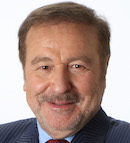
Ian F. Akyildiz
Georgia Institute of Technology
Internet of Space ThingsThe Internet of Things (IoT) for terrestrial deployments is a major part of the next generation 5G wireless systems. However, there are many use cases such as monitoring remote areas, terrain monitoring including North and South poles, intelligent global transport management, etc. which require a more global, scalable, flexible and resilient solution. In this talk, a novel architecture of the Internet of Space Things (IoST) is introduced stemming from the fast development and application of newly designed CubeSats with compact hybrid THz/Ku/X band frequency transceivers and antenna arrays. The proposed IoST architecture is based on THz band communication for achieving terabit-per-second throughputs among CubeSats. Furthermore, software-defined networking (SDN), and network function virtualization (NFV) have been incorporated to effectively separate the abstraction of functionalities from the hardware by decoupling the data forwarding plane from the control plane, such separation is of prime importance given the limited onboard processing on CubeSats. Additionally, key parameters in the constellation design including the coverage footprint and number of CubeSats as well as orbital planes, etc. are investigated for feasibility and deployment studies at different altitudes in the exosphere orbit (800 km and above). Through the new IoST architecture, a much broader spatial and service domain with greatly enhanced efficacy can be served than with the traditional IoT solutions.
Biography: I. F. Akyildiz is the Ken Byers Chair Professor with the School of Electrical and Computer Engineering, Georgia Institute of Technology, Director of the Broadband Wireless Networking Laboratory and Chair of the Telecommunications Group. He is the Editor-in-Chief of Computer Networks (Elsevier) Journal since 2000 and the founding Editor-in-Chief of the Ad Hoc Networks Journal (2003) both published by Elsevier. Dr. Akyildiz is an IEEE Fellow (1996) and an ACM Fellow (1997). He received numerous awards from IEEE and ACM. Due to Google scholar, his papers received over 103k citations and his h-index is 113 as of July 2018.
His current research interests are in Internet of xThings, 5G Wireless Systems, Software Defined Networking and Nano-Scale Communications. + More details
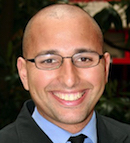
Mérouane Debbah
CentraleSupélec and Huawei, France
Wireless AI: Challenges and OpportunitiesMobile cellular networks are becoming increasingly complex to manage while classical deployment/optimization techniques are cost-ineffective and thus seen as stopgaps. This is all the more difficult considering the extreme constraints of 5G networks in terms of data rate (more than 10 Gb/s), massive connectivity (more than 1,000,000 devices per km2), latency (under 1ms) and energy efficiency (a reduction by a factor of 100 with respect to 4G network). Unfortunately, the development of adequate solutions is severely limited by the scarcity of the actual resources (energy, bandwidth and space). Recently, the community has turned to a new resource known as Artificial Intelligence at all layers of the network to exploit the increasing computing power afforded by the improvement in Moore's law in combination with the availability of huge data in 5G networks. This is an important paradigm shift which considers the increasing data flood/huge number of nodes as an opportunity rather than a curse. In this talk, we will discuss through various examples how the recent advances in big data algorithms can provide an efficient framework for the design of Intelligent Networks.
Biography: Mérouane Debbah is a Full Professor at CentraleSupelec (Gif-sur-Yvette, France) and the Director of the Mathematical and Algorithmic Sciences Lab, Huawei. He is an IEEE Fellow, a WWRF Fellow and a member of the academic senate of Paris-Saclay. He is a leading researcher in wireless communications. His works have been cited around 17k times, having an h-index of 62 as of December 2017. Mérouane Debbah is an IEEE Fellow and recipient of several prestigious awards.
Mérouane Debbah entered the Ecole Normale Supérieure Paris-Saclay (France) in 1996 where he received his M.Sc and Ph.D. degrees respectively. He worked for Motorola Labs (Saclay, France) from 1999-2002 and the Vienna Research Center for Telecommunications (Vienna, Austria) until 2003. From 2003 to 2007, he joined the Mobile Communications department of the Institut Eurecom (Sophia Antipolis, France) as an Assistant Professor. Since 2007, he is a Full Professor at CentraleSupelec (Gif-sur-Yvette, France).
From 2007 to 2014, he was the director of the Alcatel-Lucent Chair on Flexible Radio. Since 2014, he is Vice-President of the Huawei France R&D center and director of the Mathematical and Algorithmic Sciences Lab.
He is an Associate Editor in Chief of the journal Random Matrix: Theory and Applications and was an associate and senior area editor for IEEE Transactions on Signal Processing respectively in 2011-2013 and 2013-2014.
Mérouane Debbah is a recipient of the ERC grant MORE (Advanced Mathematical Tools for Complex Network Engineering). He has managed 8 EU projects and more than 24 national and international projects.
He received 17 best paper awards, among which: 2007 IEEE GLOBECOM best paper award, Wi-Opt 2009 best paper award, 2010 Newcom++ best paper award, WUN CogCom Best Paper 2012 and 2013 Award, 2014 WCNC best paper award, 2015 ICC best paper award, 2015 IEEE Communications Society Leonard G. Abraham Prize, 2015 IEEE Communications Society Fred W. Ellersick Prize, 2016 IEEE Communications Society Best Tutorial paper award, 2016 European Wireless Best Paper Award, 2017 EURASIP Best Paper Award, Valuetools 2007, Valuetools 2008, CrownCom2009, Valuetools 2012 and SAM 2014 best student paper awards.
Mérouane Debbah is the recipient of the Mario Boella award in 2005, the IEEE Glavieux Prize Award in 2011, and the Qualcomm Innovation Prize Award in 2012. He is the co-founder of Ximinds and Ulanta.
His research interests lie in fundamental mathematics, algorithms, statistics, information & communication sciences research.
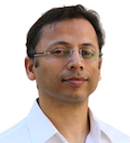
Syed A. Jafar
University of California Irvine
Robust GDoF Outer Bounds for Wireless Interference Networks based on Aligned Image SetsStructured codes are known to offer tremendous advantages for wireless networks. However, the benefits of such coding schemes depend strongly on the level of channel uncertainty. The fundamental tradeoff between structure and channel uncertainty is therefore essential to any capacity characterization of wireless networks, including asymptotic/approximate metrics such as the Generalized Degrees of Freedom (GDoF). In particular, finding tight outer bounds for GDoF under channel uncertainty has been a challenge. An approach based on "Aligned Image Sets" (AIS) has allowed progress on this frontier. This talk is an overview of the AIS approach, the insights that it reveals and the challenges ahead.
Biography: Syed Jafar is a Professor in the Department of Electrical Engineering and Computer Science at the University of California Irvine, Irvine, CA USA. Dr. Jafar was elevated to IEEE Fellow, Class of 2014, for contributions to analyzing the capacity of wireless communication networks. He is one of the most influential researchers in information theoretic aspects of wireless communications and co-inventor of interference alignment in MIMO interference networks. He has over 23k citations and has an h index of 61, as of December 2017.
Syed Ali Jafar received his B. Tech. from IIT Delhi, India, in 1997, M.S. from Caltech, USA, in 1999, and Ph.D. from Stanford, USA, in 2003, all in Electrical Engineering. His industry experience includes positions at Lucent Bell Labs, Qualcomm Inc. and Hughes Software Systems.
Dr. Jafar received the Blavatnik National Laureate in Physical Sciences and Engineering in 2015, the UCI Academic Senate Distinguished Mid-Career Faculty Award for Research in 2015, the School of Engineering Mid-Career Excellence in Research Award in 2015, the School of Engineering Maseeh Outstanding Research Award in 2010, the ONR Young Investigator Award in 2008, and the NSF CAREER award in 2006.
His co-authored papers received the IEEE Information Theory Society Best Paper Award in 2009, IEEE Communications Society Best Tutorial Paper Award in 2013, IEEE Communications Society Heinrich Hertz Award in 2015, IEEE Signal Processing Society Young Author Best Paper Award (to student co-authors) in 2015, an IEEE GLOBECOM Best Paper Award in 2012 and an IEEE GLOBECOM Best Paper Award in 2014
Dr. Jafar received the UC Irvine EECS Professor of the Year award five times, in 2006, 2009, 2011, 2012, and 2014, from the Engineering Students Council and the Teaching Excellence Award in 2012 from the School of Engineering. He was a University of Canterbury Erskine Fellow in 2010 and an IEEE Communications Society Distinguished Lecturer for 2013-2014. Dr. Jafar was recognized as a Thomson Reuters Highly Cited Researcher and included by Sciencewatch among The World's Most Influential Scientific Minds in 2014 and again in 2015. He served as Associate Editor for IEEE Transactions on Communications 2004-2009, for IEEE Communications Letters 2008-2009 and for IEEE Transactions on Information Theory 2009-2012. Dr. Jafar was elevated to IEEE Fellow, Class of 2014, for contributions to analyzing the capacity of wireless communication networks.
His research interests include multiuser information theory, wireless communications and network coding.
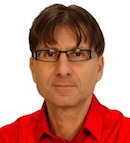
Angel Lozano
Universitat Pompeu Fabra
5G is here. Now what?With the 5th generation of wireless networks in the horizon, the time is right to reflect on what has been accomplished, on challenges old and new, on the research tools at our disposal, and on the evolution of wireless communications at large. This lecture intends to contribute to this reflection, not from the perspective of a manufacturer, operator, or user, but from the perspective of a researcher. With this perspective, the presentation is organized around various ideas that relate to 5G, but that also have broader conceptual implications.
Biography: Angel Lozano is a Professor at Universitat Pompeu Fabra (UPF) in Barcelona. He is also UPF's Vice-Rector for Research. He is a Fellow of the IEEE and a Highly Cited Researcher. He is one of the most influential researchers in signal processing and information theory for MIMO systems, having contributed to 15 patents, and has an h index of 43 and 11k citations to his work, as of December 2017.
Prof. Lozano received the M.Sc. and Ph.D. degrees in Electrical Engineering from Stanford University, USA, in 1994 and 1998, respectively. In 1999, he joined Bell Labs (Lucent Technologies, now Alcatel-Lucent) in Holmdel, USA, where he was a member of the Wireless Communications Research Department until 2008. Between 2005 and 2008 he was also an Adjunct Associate Professor of Electrical Engineering at Columbia University, NY, USA.
He has served as associate editor for the IEEE Transactions on Information Theory (2011-2014), the IEEE Transactions on Communications (1999-2009) and the Journal of Communications & Networks (2010-2012), has guest-edited various journal special issues, and is actively involved in committees and conference organization tasks for the IEEE. In particular, he was Chair of the IEEE Communication Theory Technical Committee (2013-2014) and an elected member of the Board of Governors of the IEEE Communications Society (2012-2014) and he is a current member of the steering committee for the IEEE Wireless Communication Letters. He currently is the Area Editor for the IEEE Transactions on Wireless Communications.
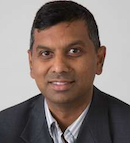
Harish Viswanathan
Nokia Bell Labs, NJ, USA
5G and Beyond: Enabling the Next Generation of Industrial AutomationA transformation in private industrial networks from wired cable and fiber networks to wireless networks is imminent. Reconfigurable production stations and increasing use of autonomous machines will require wireless networks with wireline equivalent sub millisecond latency and five to nine 9s reliability. 5G is expected to serve as the backbone for these future industrial networks, and numerous technology enablers have been developed to meet these stringent requirements. We will begin with a discussion of some of the major the use cases driving the requirements and then briefly summarize the technologies standardized in 5G Phase 1. Then we will take a deeper dive into motion control in factory floors and discuss novel solutions incorporating feedback and cooperative relaying to achieve the nine 9s reliability with 1 ms cycle times.
Biography: Harish Viswanathan is Head of the Radio Systems Research Group. He leads an international team of researchers investigating various aspects of wireless communication systems, and in particular, 5G. In his prior role, as a CTO Partner he was responsible for advising the Corporate CTO on Technology Strategy through in-depth analysis of emerging technology and market needs. Harish Viswanathan joined Bell Labs in 1997 and has worked on multiple antenna technology for cellular wireless networks, mobile network architecture, and IoT. He received the B. Tech. degree from the Department of Electrical Engineering, Indian Institute of Technology, Madras, India and the M.S. and Ph.D. degrees from the School of Electrical Engineering, Cornell University, Ithaca, NY. He holds more than 50 patents and has published more than 100 papers. He is a Fellow of the IEEE and a Bell Labs Fellow.
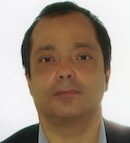
Jorge Pereira
DG Connect, European Commission
5G for Growth, 5G for GoodA lot has been discussed about the potential impact of 5G across the economy, namely in the many verticals starting with the ones that have been highlighted in the many impact studies. This keynote goes beyond that, to discuss the potential impact of 5G in other areas where the impact goes beyond the economic. Namely, it will address that security enhancement impact of 5G in the area of Intelligent Transportation Systems (ITS) Safety and the improvement of response in the area of Public Protection and Disaster Relief (PPDR).
Biography: Dr. Jorge M. Pereira obtained the Engineering and M.Sc. degrees in Electrical and Computer Engineering from Instituto Superior Técnico (IST), Lisbon, Portugal in 1983 and 1987, respectively; he received the Ph.D. in Electrical Engineering-Systems from the University of Southern California, Los Angeles, in 1993.
Since September 1996, he has been with the European Commission, with DG XIII, later DG Information Society and Media (INFSO), and now DG Communications Networks, Content and Technology (CONNECT), as Scientific Officer in the areas of Mobile and Personal Communications and Broadband for All. He became Principal Scientific Officer in 2005, moving to the area of ICT for Sustainable Growth, with a focus on Energy Efficiency and Emergency and Disaster Management. In 2008, he moved to the area of Embedded Systems and Control, where he was responsible for the area of Wireless Sensor Networks and Cooperating Objects. In 2011, he moved to the area of Future Internet Research and Experimentation (FIRE), making available to European experimenters, industry and research alike, open platforms for experimentation. Finally, in 2016 he moved to the area of Future Connectivity Systems, were he is responsible for the areas of IPv6, Spectrum, Public Protection and Disaster Relief (PPDR) and Connected and Automated Mobility (CAM), while remaining involved in experimentation and trials in the context of 5G.
He received the Software-Defined Radio (SDR) Forum 2003 Industry Achievement Award in recognition of his “outstanding contributions, research and development in the field of SDR”.
He is a member of the Advisory Board of John Wiley's Wireless Communications and Mobile Computing Journal, and of the Editorial Board of Kluwer Academic Publishers' Wireless Personal Communications Journal.
He is a Member of the IEEE and of the ACM. He serves as Associate Editor for Mobile Radio, including Vehicular Communications, for the IEEE VTS Magazine, and was Associate Editor of the ACM Transactions on Sensor Networks.








